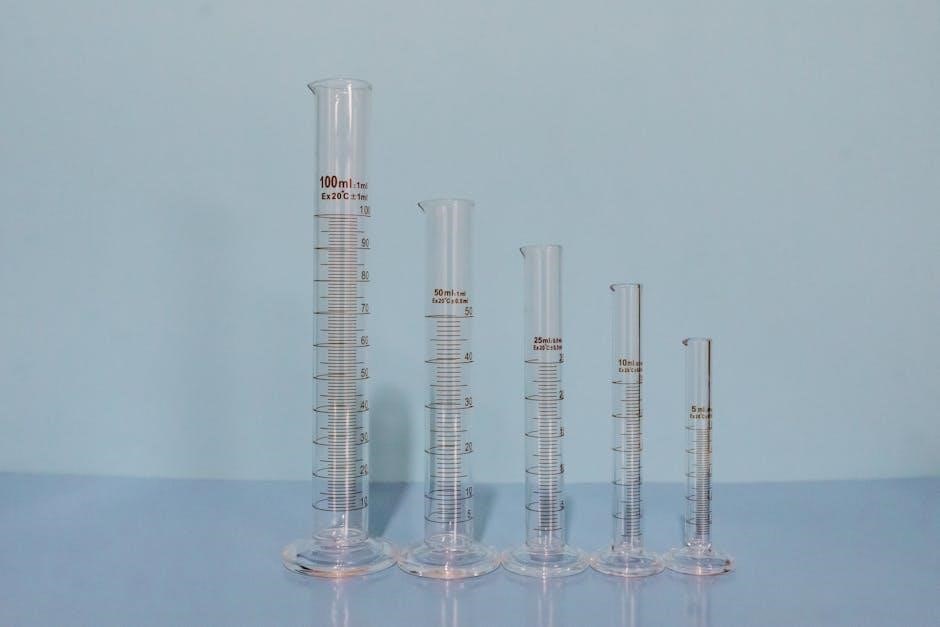Socket Size Chart: Metric and Standard (SAE)
A socket size chart is essential for anyone working with fasteners․ It provides a quick reference for both metric and standard (SAE) socket sizes, helping you select the right tool for the job․ You can also download a PDF chart․
Understanding Socket Sizes
Socket sizes refer to the measurement across the flats of a nut or bolt head․ Sockets are designed to fit snugly onto these fasteners, allowing you to apply torque with a wrench or ratchet․ Understanding socket sizes is crucial for efficient and safe work, preventing damage to both the fastener and your tools․
Sockets come in two main systems: metric and standard (SAE)․ Metric sockets are measured in millimeters (mm), while standard sockets are measured in inches․ It’s important to use the correct socket size for the corresponding fastener to avoid slippage and rounding of the edges, which can make the fastener difficult or impossible to remove․
Socket sets typically include a range of sizes to accommodate various applications․ The drive size of a socket, such as 1/4″, 3/8″, or 1/2″, refers to the size of the square opening that connects to the wrench or ratchet․ Different drive sizes are designed for different torque ranges, with larger drive sizes being used for heavier-duty applications․
Choosing the right socket size involves identifying whether the fastener is metric or standard and then selecting the socket that matches the fastener’s dimensions․ Using a socket size chart can greatly simplify this process, providing a quick reference for matching socket sizes to fastener sizes․
Metric Socket Sizes
Metric socket sizes are measured in millimeters (mm) and are commonly used in automotive, machinery, and construction applications, particularly on equipment manufactured outside of the United States․ A comprehensive chart is essential for quick reference․
Common Metric Socket Sizes and Applications
Metric sockets are essential for working on vehicles, machinery, and various projects, especially those involving imported or modern hybrid products․ Common metric socket sizes range from 4mm to 24mm, with popular sizes including 10mm, 13mm, and 17mm․ These sizes are widely used internationally and comply with international standards․
Common Metric Socket Sizes:
- 4mm to 10mm: These smaller sizes are often used for electronics, small engines, and detailed mechanical work․ For example, a 4mm socket might be used on small fasteners in a motorcycle or to disassemble parts of a computer․ The 5mm, 6mm, 7mm, and 8mm sockets are also common in these types of applications․
- 10mm to 14mm: These mid-range sizes are commonly found in automotive applications for securing various components, such as sensors, brackets, and interior parts․ The 10mm socket, in particular, is known for its frequent use in car repairs, making it a staple in any mechanic’s toolkit․ The 12mm and 14mm sizes are also frequently used in similar applications․
- 15mm to 19mm: These larger sizes are used for more substantial automotive work, including suspension components, engine parts, and brake systems․ A 17mm socket, for instance, is often used to tighten lug nuts or work on larger bolts in the engine bay․ The 15mm, 16mm, 18mm, and 19mm sizes are all essential for handling bigger, more demanding jobs․
- 20mm to 24mm: These sizes are typically used for heavy machinery, industrial equipment, and large vehicles․ They are ideal for tasks that require high torque and robust fasteners․ Examples include working on heavy-duty trucks, construction equipment, and agricultural machinery․
It’s important to have a comprehensive set of metric sockets to handle a wide range of tasks efficiently․ Using the correct size socket ensures a secure fit, preventing damage to the fastener and ensuring that the job is done correctly․ Metric sockets are also essential for tasks that require precision and adherence to international standards․
For easy reference, a metric socket size chart can be downloaded as a PDF, providing a quick guide to ensure you have the right socket for any given job․ This helps mechanics, DIYers, and professionals alike to quickly identify the appropriate socket size, making their work more efficient and accurate․

Standard (SAE) Socket Sizes
Standard (SAE) socket sizes are commonly used in North America, particularly for older vehicles and machinery․ These sockets are measured in inches and fractions of inches, and a comprehensive chart is vital for identifying the correct size․
Common Standard Socket Sizes and Applications
Standard (SAE) socket sizes are prevalent in various applications across North America, especially in industries that have historically used imperial measurements․ Understanding the common sizes and their specific uses is crucial for mechanics, DIY enthusiasts, and professionals alike․ Here’s a breakdown of some frequently encountered SAE socket sizes and their typical applications:
- 1/4″ Drive Sockets: These smaller sockets are often used for light-duty tasks and accessing tight spaces․ Common sizes include 5/32″, 3/16″, 7/32″, 1/4″, 9/32″, and 5/16″․ They are frequently employed in automotive interior work, small engine repair, and electronics assembly․
- 3/8″ Drive Sockets: This is a versatile drive size suitable for a wide range of applications․ Popular sizes range from 1/4″ to 3/4″, including 3/8″, 7/16″, 1/2″, 9/16″, and 5/8″․ They are commonly used in automotive repair, general mechanical work, and household maintenance tasks․
- 1/2″ Drive Sockets: These larger sockets are designed for heavier-duty applications where more torque is required․ Common sizes include 1/2″, 9/16″, 5/8″, 11/16″, 3/4″, 13/16″, 7/8″, and 15/16″․ They are frequently used in automotive suspension work, engine repair, and industrial machinery maintenance․
- 3/4″ Drive Sockets: These are the largest commonly used sockets, designed for high-torque applications such as heavy equipment repair and industrial maintenance․ Sizes typically range from 3/4″ to 2″, with common sizes including 1″, 1-1/8″, 1-1/4″, and 1-1/2″․
When working with SAE sockets, it’s important to note that the specific application often dictates the required size․ Consulting a socket size chart can help ensure you select the correct socket for the job, preventing damage to fasteners and ensuring efficient work․ Additionally, having a comprehensive set of SAE sockets in various drive sizes will equip you to handle a wide range of tasks․

SAE to Metric Conversion Chart
A SAE to Metric conversion chart is a vital tool for easily converting between standard (SAE) and metric socket sizes․ This chart simplifies identifying equivalent sizes, ensuring compatibility and preventing damage to fasteners during projects;
Using the Conversion Chart
To effectively use an SAE to Metric conversion chart, begin by locating the known size – either SAE (standard) or metric – in the appropriate column․ Once found, simply read across the row to identify the corresponding size in the opposite measurement system․ This direct comparison allows for quick and accurate conversions, preventing the use of incorrect socket sizes․ For example, if you have a bolt head that measures 1/2 inch (SAE), find “1/2” in the SAE column and then look across to the metric column to find the equivalent metric size, which would be approximately 13mm; Similarly, if you know you need a 10mm socket, find “10mm” in the metric column and read across to see the closest SAE equivalent, which is roughly 3/8 inch․ Note that some sizes are only approximate equivalents, and the chart may also provide the decimal inch equivalent for greater precision․ Always double-check the fit to ensure you’ve selected the right socket, as forcing an ill-fitting socket can damage both the fastener and your tools․ Many charts also include additional information, such as tap drill sizes or hex key sizes, making them even more versatile․ For convenience, it’s a good idea to keep a printed copy of the conversion chart readily available in your workspace, or to have a digital version saved on your devices for quick access․ This simple step can save time and prevent frustration during any project involving both SAE and metric measurements․

Wrench and Socket Drive Size Chart
A wrench and socket drive size chart is an indispensable tool for anyone working with sockets and wrenches, whether you’re a professional mechanic, a DIY enthusiast, or simply tackling home repairs․ This chart provides a comprehensive overview of the different drive sizes available, ensuring you select the correct tools for your specific needs․ The most common drive sizes are 1/4 inch, 3/8 inch, 1/2 inch, and 3/4 inch, with each drive size capable of handling a certain range of socket sizes․ A 1/4-inch drive is typically used for smaller sockets, ranging from 4mm to 14mm (metric) or 5/32 inch to 9/16 inch (SAE)․ It’s ideal for delicate work where precision is crucial․ The 3/8-inch drive is a versatile mid-range option, accommodating sockets from 6mm to 22mm (metric) or 1/4 inch to 7/8 inch (SAE)․ It strikes a balance between power and maneuverability, making it suitable for a wide variety of tasks․ For heavier-duty applications, a 1/2-inch drive is the go-to choice, handling larger sockets from 8mm to 36mm (metric) or 5/16 inch to 1-1/2 inch (SAE)․ This drive provides increased torque and is commonly used on automotive repairs and industrial projects․ Finally, the 3/4-inch drive is reserved for the most demanding tasks, capable of accommodating very large sockets used on heavy equipment and machinery․ The chart also includes information on hex key sizes, equivalent standard bolt diameters, and various socket types (such as regular hex, heavy hex, socket head, and button/flat socket)․ Having a wrench and socket drive size chart readily available ensures you can quickly identify the correct drive size and socket for any job, saving time and preventing damage to fasteners and tools․
Downloading a Printable PDF Chart
Downloading a printable PDF chart of socket sizes, encompassing both metric and standard (SAE) measurements, offers unparalleled convenience and accessibility for professionals and DIY enthusiasts alike․ A PDF format ensures that the chart retains its formatting and clarity across various devices and operating systems, making it easily viewable on computers, tablets, and smartphones․ The primary advantage of having a printable PDF chart lies in its offline availability․ In situations where internet access is limited or non-existent, a downloaded chart provides immediate access to crucial socket size information, preventing delays and ensuring project continuity․ Furthermore, a printed chart can be physically taken to the workshop, garage, or job site, allowing for quick and easy reference without the need for electronic devices, which can be susceptible to damage or battery depletion in demanding environments․ A comprehensive socket size chart PDF typically includes a detailed listing of both metric and standard socket sizes, often presented in a side-by-side comparison for easy conversion․ This feature is particularly useful when working with projects that involve both types of fasteners․ The chart may also incorporate additional information, such as wrench sizes, hex key sizes, and equivalent bolt diameters, providing a holistic reference guide for various fastening needs․ Some advanced charts even include torque specifications for different socket sizes, which is crucial for ensuring proper tightening and preventing over-tightening or stripping of fasteners․ When selecting a socket size chart PDF, it’s essential to choose one that is clearly formatted, easy to read, and includes the specific sizes and information relevant to your work․ Ensure the chart is up-to-date and accurate to avoid errors․ By downloading and printing a reliable socket size chart PDF, you equip yourself with a valuable resource that enhances efficiency, accuracy, and overall success in any fastening-related task․

How to Choose the Right Socket Size
Choosing the right socket size is crucial for effectively and safely working with nuts and bolts, preventing damage to both the fastener and your tools․ The primary step involves accurately identifying whether the fastener is metric or standard (SAE)․ Metric fasteners are widely used internationally and are common on imported vehicles and equipment, while standard (SAE) fasteners are predominantly used in the United States․ Mismatched socket sizes can lead to rounding off the corners of the nut or bolt head, making it difficult or impossible to tighten or loosen․ Once you’ve determined whether the fastener is metric or standard, you need to measure its size․ For metric fasteners, sizes are typically expressed in millimeters (mm), while standard fasteners are measured in inches․ If the size is not readily visible on the fastener, you can use a wrench or socket size chart to visually match the fastener to the corresponding size․ Alternatively, a caliper can provide precise measurements to determine the exact size․ It’s essential to select a socket that fits snugly on the fastener, without any excessive play․ A loose fit increases the risk of slippage and damage․ When working with power tools, such as impact wrenches, it’s crucial to use impact-rated sockets, which are designed to withstand the high torque and stresses generated by these tools․ Using regular sockets with power tools can lead to cracking or shattering, posing a safety hazard․ Consider the depth of the socket as well․ Deep sockets are useful for accessing nuts or bolts that are located in recessed areas or have long threads․ Standard depth sockets are suitable for most general applications․ Finally, always inspect the socket for any signs of wear or damage before use․ Cracks, rounded corners, or other imperfections can compromise the socket’s strength and increase the risk of failure․ By following these steps, you can confidently choose the right socket size for any task, ensuring efficient and safe operation․
Applications of Metric and Standard Sockets
Metric and standard (SAE) sockets find widespread applications across various industries and DIY projects, each serving distinct purposes based on the fastener types used․ Metric sockets, conforming to international standards, are commonly employed in automotive repair, particularly on imported vehicles where metric fasteners are the norm․ They are also prevalent in the assembly and maintenance of machinery, equipment, and appliances manufactured using metric specifications․ The precision and accuracy of metric measurements make them ideal for applications requiring tight tolerances and precise fits․ Standard (SAE) sockets, on the other hand, are predominantly used in North America, especially in the automotive industry for domestic vehicles and in the construction sector for projects utilizing standard-sized fasteners․ They are also frequently found in older machinery and equipment that were originally designed using standard measurements․ The robust and durable nature of standard sockets makes them suitable for heavy-duty applications where high torque and resistance to wear are essential․ Beyond automotive and industrial uses, both metric and standard sockets are indispensable tools for homeowners and DIY enthusiasts․ They are used for a wide range of tasks, including furniture assembly, plumbing repairs, electrical work, and general maintenance around the house․ Socket sets that include both metric and standard sizes provide versatility and ensure that you have the right tool for any job․ Choosing the appropriate socket type depends on the specific application and the type of fasteners being used․ Using the correct socket size and type is crucial for preventing damage to fasteners and ensuring safe and effective operation․ Whether you’re a professional mechanic, a construction worker, or a DIY enthusiast, having a comprehensive set of metric and standard sockets is essential for tackling a wide variety of projects․

